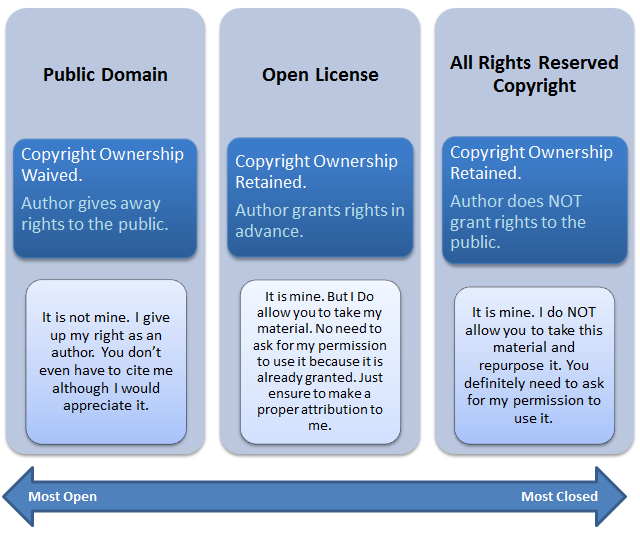4 A note about the Public Domain…
What is the Public Domain?
A public domain work is a creative work that is not protected by copyright, which means it’s free for you to use without permission. Works in the public domain are those for which intellectual property rights have expired, have been forfeited, or are inapplicable.
Here are some examples of works in the public domain:
- Material created by the US Government, such as pictures taken by NASA
- Materials for which Copyright Protection has lapsed, such as “New Hampshire” by Robert Frost
- Works released to the public domain when they were created, such as images on Pexels
Determining if a work is in the public domain can be difficult because the terms of copyright protection in the United States have changed over time. The Cornell University Library Copyright Information Center is a useful tool for understanding what works might fall into the public domain.
What is the Difference Between Public Domain and Open License?
They both grant free access to the materials, but the scope and nature are completely different.
Open licensing does recognize clear ownership of intellectual property and the work is still protected under copyright law, whereas works in the public domain are not protected by copyright law. Therefore, users are required to follow the license requirements when using openly licensed materials.
This infographic illustrates the differences between public domain, open license, and all rights reserved copyright.

Why Open Licensing Matters
The power of open licensing lies in its ability to clearly communicate how the creator intends the work to be used. A creator can explicitly share the work and control the licensing provisions while retaining ownership. Remember, for a work without a copyright notice, all rights reserved is assumed. So if you want to openly share your OER with your students and faculty peers, or publish it online for the world to access, displaying an open copyright license statement with the work ensures it will be easily and clearly adopted in the way you intend.
In Chapter 8 you will spend more time learning about the permissions behind the six different Creative Commons Licenses. In that module, you will focus on distinguishing between the different permissions for adoption, adaptation, creation, attribution, and reuse. This module serves as an introduction and overview of copyright, fair use, public domain, and open licenses.
Concept Review
Fill in the blanks below using terms from the following list: copyright, copyleft, creative commons, public domain, permissions, attribution, fair use, openly licenses
(Disregard the need for capitalization)

